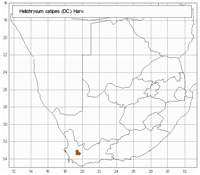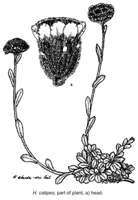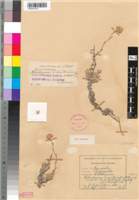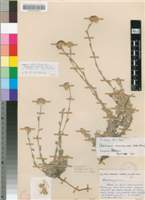Origin of name:
Diagnostic characters:
Medium-sized headsCompact inflorescenceLeaves broad, woolly-hairyLeaves crowded at the base, flowering stems sparsely hairy
Description:
Bushy perennial herb, vegetative twigs congested, thin, woody, erect (?) or spreading, closely leafy, flowering twigs elongate, distantly leafy, all grey-woolly. Leaves mostly 6-13 x 3-6 mm, oblong-ovate, longer and narrower (c. 9-12 x 3 mm) on the flowering twigs, apex rounded, mucronate, base broad, clasping, both surfaces thinly greyish-woolly. Heads heterogamous, campanulate, c. 5 x 3 mm, c. 6-12 in congested terminal clusters surrounded by leaf-like bracts each with a scarious appendage, webbed together with wool. Involucral bracts in c. 4 series, scarcely graded, loosely imbricate, inner slightly shorter than flowers, oblong, tips rounded, straw-yellow, subopaque, minutely radiating, all but these tips loosely enveloped in wool. Receptacle honeycombed. Flowers c. 26-28, 5-7 female, 20-22 homogamous. Achenes 1 mm long, cylindric, with duplex hairs, not myxogenic. Pappus bristles many, scabrid, tips barbellate, bases cohering lightly by patent cilia, some light fusion as well.
Flowering in December and March.
Distribution:
Miss Esterhuysen records 'slopes at foot of shale band' and 'shaly slopes with step ledges, in low bush' between c. 1 500 and 1 800 m. Endemic to the SW. Cape and recorded from the Cedarberg, Hex River Mountains, Skurfdeberg and Bokkeveld Sneeukop.
Fynbos Biome.
Notes:
Rarely collected.
Taxonomy:
Literature:
Helichrysum catipes (DC.) Harv. in F.C. 3: 223 (1865).
Type:
Cape, Cedarberg, Dr�ge 2837 (G-DC, holo.; G; P; S, iso.).
Synonym(s):
Briosphaera catipes DC., Prodr. 6: 167 (1838).
Helichrysum anaxetonoides Schltr. & Moeser in Bot. Jb. 44: 289 (1910). Type: Klein Namaland, Koude Bokkeveld, Skurfdebergen, Elandsfontein, 1 540 m, Schlechter 10035 (BM; BOL; G; K; PRE; Z, iso.).
Vouchers:
Esterhuysen 20951 (BOL; K; M; NBG; PRE); Esterhuysen 30108 (BOL; PRE).



